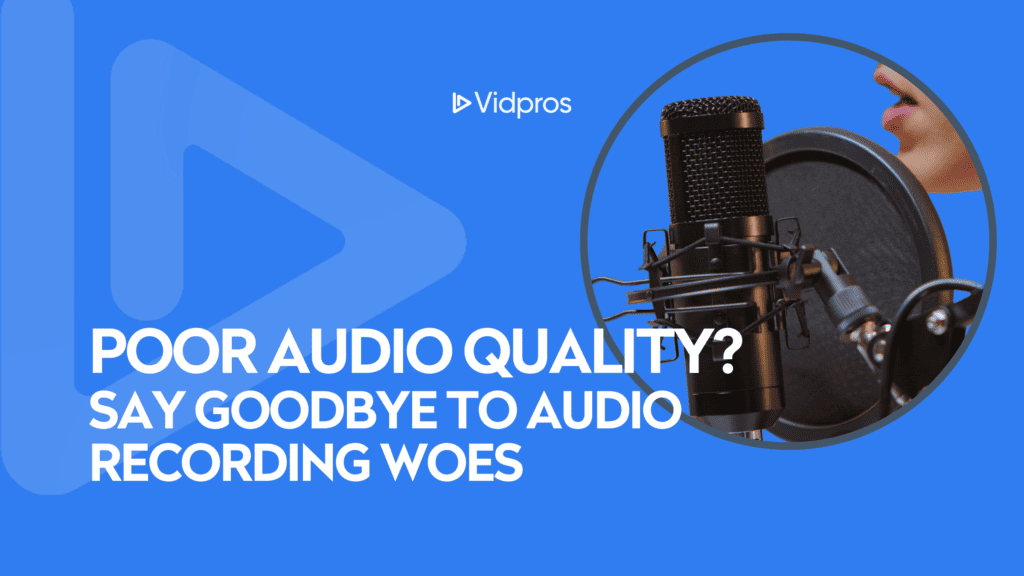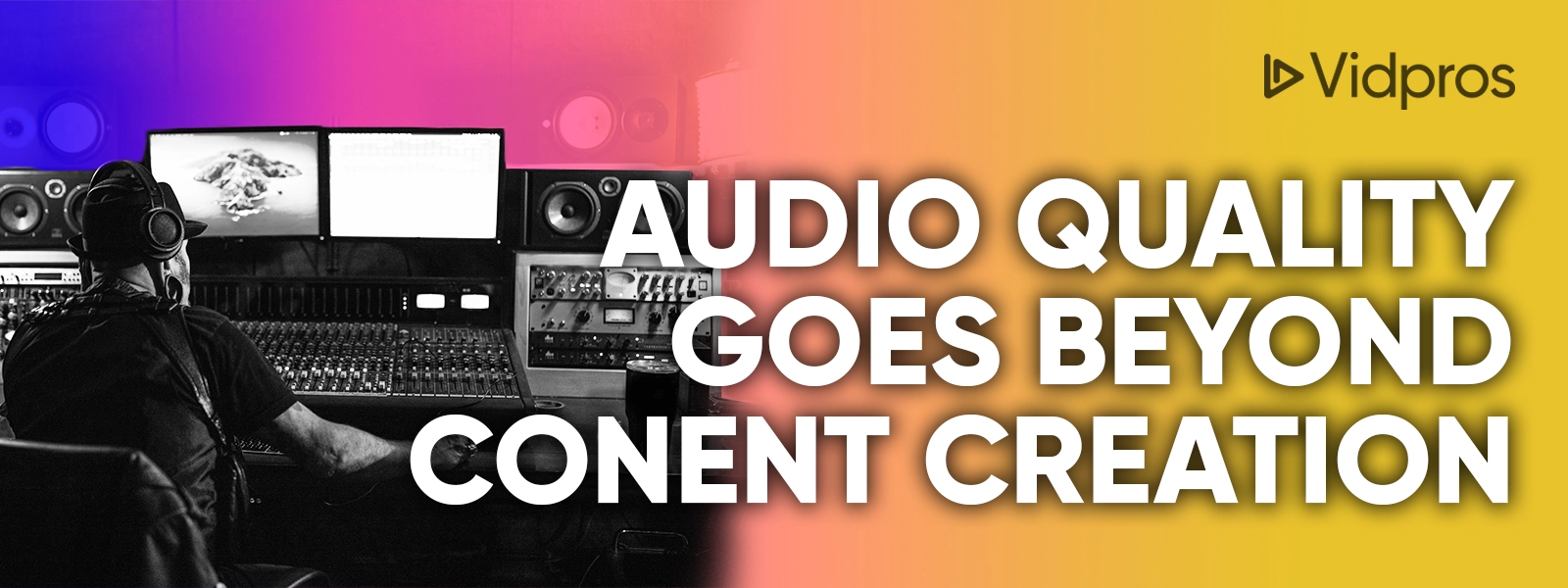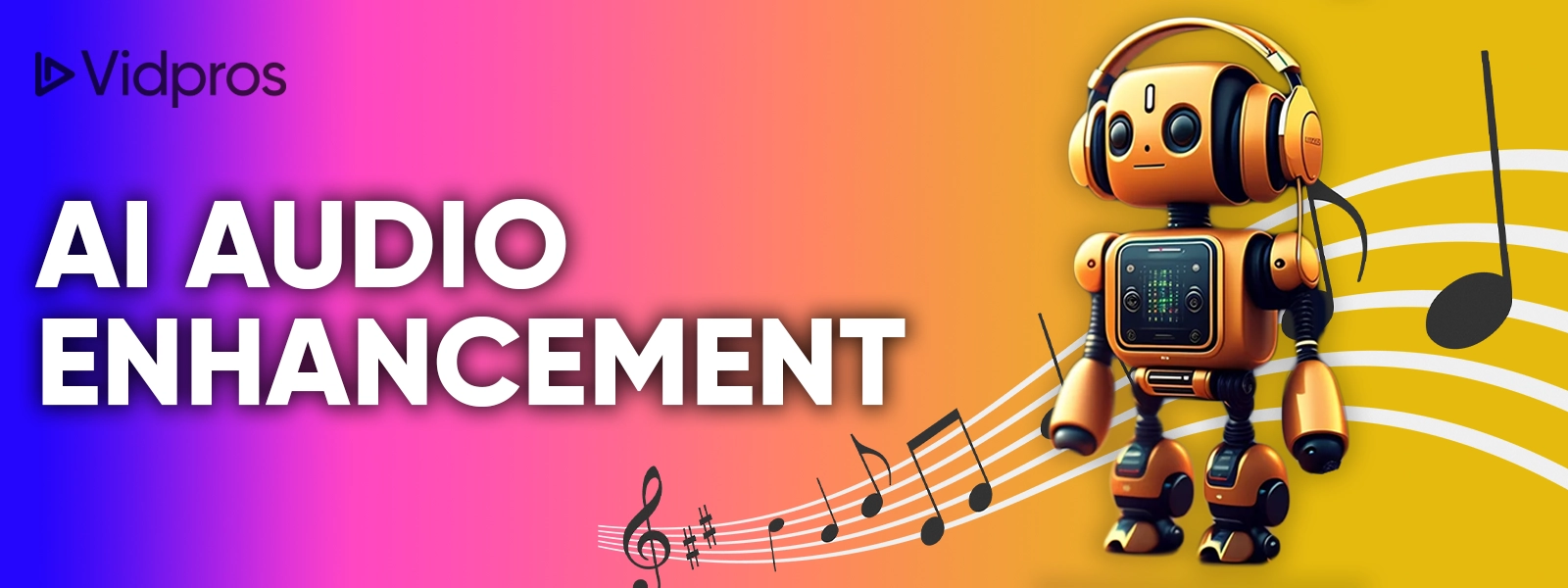Audio-related issues are one of the biggest problems facing video content creators today. From low-quality audio recordings to loud and distracting background noise, audio issues can ruin a great piece of content.
It may seem trivial, but the audio is key to making or breaking the success of your video content.
You think, “it’s just audio. How big of a deal is that?”
For one, the low-quality sound makes a video seem amateurish and unprofessional that can turn off viewers, so content creators must take care to get their audio just right.
Some of the most common audio-related issues are unwanted background noise, low-quality recordings, unbalanced volume levels, and incorrect or poor audio compression – those are just the most common ones.
Audio-related issues are one of the biggest hangups for video content creators. Poorly recorded sound can harm a piece of content and turn away viewers. Therefore, content creators must be aware of the potential issues and work to ensure that their recordings are of the highest quality.
But audio quality goes beyond content creation and has real-world implications.
In 2011, a recording of a telephone conversation between News Corporation executive James Murdoch and a senior executive at the company’s British newspaper division was leaked to the media.
The recording revealed that the executive knew the extent of phone hacking at the company’s newspapers, contrary to previous statements.
This recording was a key piece of evidence in the phone-hacking scandal that led to the closure of the News of the World newspaper and a significant loss of public trust in the company and its leadership.
Here’s another one. In 2017, a live broadcast of the Academy Awards ceremony had audio syncing issues.
Due to a technical glitch, the live broadcast audio was delayed by several seconds, making it difficult for viewers to understand what was happening on stage.
This issue caused widespread confusion and frustration among viewers and resulted in adverse publicity for the awards ceremony.
Both of these examples show how quality audio recording can be a crucial piece of evidence, or those with issues can have severe negative impacts, whether in terms of public trust and perception or a significant loss in revenue and reputation.
Now, what if a similar issue happened to you?
Video content creators are always at the mercy of their content output. In the online sphere, they may encounter various audio issues that can affect the quality of their content.
While investing in expensive and superior quality microphone or audio recording equipment can prevent or mitigate audio-related issues, there’s no guarantee that it will not fail at one point during the recording process.
Background noise, echoes and reverb, distorted audio, low-quality microphone, inconsistent audio levels, speech volume, and audio syncing, to name a few.
These are some common audio issues that affect the video content.
Still, you can encounter many other problems based on the specific conditions and equipment used during recording.
When all else fails…
Thanks to technology, we have audio enhancement tools.
More specifically, AI audio enhancers can solve various issues with audio recordings, including noise reduction, background noise, traffic, wind, air conditioning, fan – just about anything that could ruin the quality of your audio recording.
You’ll be surprised at the extent of enhancements that these tools can do to improve your audio recording’s overall sound quality.
How does AI apply to audio enhancement?
Artificial intelligence (AI) is used in audio enhancement software to analyze and improve the quality of audio recordings. The applications use advanced algorithms to analyze the audio signal and identify specific problems such as noise, echo, or distortion.
Once the audio problem is identified or detected, the AI algorithm applies the appropriate processing technique to improve the audio.
For example, if the software detects background noise, it will apply a noise reduction algorithm to remove the noise without affecting the desired audio—the same thing to echoes. In addition, the program will use a de-reverberation algorithm to remove the echo.
One of the critical advantages of AI-based audio enhancement is its ability to adapt and learn.
You can train AI algorithms on large sets of audio data. Then, over time, they can learn to identify specific types of noise and apply the most appropriate processing techniques to isolate and remove it.
Deep learning is a commonly-applied AI technology used in audio enhancement where an AI model is trained on a large set of audio data and subsequently used to process new audio.
These deep learning models can learn complex patterns and relationships in the audio data, allowing them to make sophisticated decisions about how to process the audio or apply changes and corrections.
Another technology used in audio enhancement is Non-negative Matrix Factorization (NMF), a technique that separates audio into different components, such as speech and background noise. This method is widely used for speech enhancement and noise reduction.
Here are a few examples of real-world use cases of AI audio enhancers:
Automatic noise reduction
The system uses AI algorithms to remove background noise from audio recordings in real time.
This can be particularly useful for enhancing Video conferencing or live streaming audio quality, where background noise can be a significant issue.
Speech enhancement
AI-based speech enhancement systems can improve the clarity and intelligibility of speech in noisy or reverberant environments. This technology is widely used in hands-free mobile devices, personal assistant devices, and telecommunication systems.
Music Production
You can use AI-based music production systems to generate new music or modify an existing theme. For example, AI-based systems can be used to create new melodies, drum patterns, or harmonies or to adjust the balance of frequencies in a piece of music.
Voice recognition
AI-based speech recognition technology has become widespread, it can be used in many applications such as transcription and translation, and in personal assistant devices, allowing users to interact with their devices using voice commands.
Audio restoration and archiving
AI can be used for audio restoration and archiving, where You can use it to enhance audio recordings that have been damaged or degraded over time, such as old vinyl records or tapes.
Automatic lip-syncing for animation
AI-based technology is also used in the animation industry for generating realistic lip-sync and facial expressions, which helps in saving time and costs in animation production.
But mind you, these are just a few, as AI audio enhancers have many other potential uses across various industries and applications.
What do you do about it?
Here are several groundbreaking tools you can use to ensure you get good audio results, whether recording your content or editing your videos for posting.
iZotope RX
A software suite of audio repair and enhancement tools that utilizes artificial intelligence and machine learning algorithms. It is commonly used by audio engineers, post-production professionals, and content creators to improve the quality of their audio recordings.
Watch: RX 10 De-hum, Dynamic Adaptive Mode: Remove Hum from Audio | iZotope
The software features several modules for repairing and enhancing audio, including:
De-noise removes unwanted background noise, De-clip repairs and restores clipped or distorted audio, de-click for unwanted clicks and pops, de-hum for low-frequency noises or electrical hum, and De-verb for reverberation or echo sounds.
Other features are Dialogue Match, Music Rebalance, Spectral Repair, and much more.
Other uses for iZotope RX include:
Post-production for film and television: iZotope RX can be used to repair and enhance audio recordings for film and television projects.
Podcast and streaming: It can be used to remove background noise, remove noise from audio recorded in unsuitable conditions, and clean up audio recorded in Skype calls or Zoom calls.
Music production: It can be used to remove noise and reverb from live recordings or to enhance the quality of audio recordings in a home studio setting.
Archival audio restoration: It can be used to restore and enhance audio recordings that have been degraded over time, such as old vinyl records or tapes.
iZotope RX is a powerful audio repair and enhancement tool that allows users to fix and improve their audio recordings.
Neat Video
Neat Video is a noise reduction software that uses artificial intelligence and machine learning algorithms to remove noise and grain from video footage. The software is commonly used by video editors, colorists, and content creators to improve the visual quality of their video recordings.
Watch: Basic Workflow | Neat Video 5
The software features several tools to help reduce noise, including:
Noise reduction
A noise reduction tool that uses AI algorithms to remove noise and grain from video footage, this can be especially useful for reducing noise in low-light conditions or when shooting with high ISO values.
Grain reduction
A tool that helps to remove any unwanted grain from the video footage, which can be especially useful for footage shot on film or with high-grain digital cameras.
Color correction
A color correction tool that allows users to adjust the color and tone of their video footage can be handy for restoring the natural colors of footage that has been shot in poor lighting conditions.
Temporal filter
A filter that helps to remove noise and artifacts over time can be beneficial for Video that has been shot over a long period.
Use cases for Neat Video include;
Film and video production: Neat Video can be used to remove noise and grain from footage shot in low-light conditions or to restore the natural colors of footage that have been shot in poor-lighting conditions.
Video Editing: It can be used to remove noise and grain from footage shot with high ISO values or to improve the overall visual quality of the footage you will use in a final edit.
Webcasting, Live streaming: It can remove noise and grain from footage shot in less-than-ideal lighting or use lower-quality cameras.
VFX & Animation: Neat Video can remove noise and grain from green-screen footage, allowing the compositor to clear out the background quickly.
Audionamix
Audionamix is a software suite of audio separation and enhancement tools that utilizes artificial intelligence and machine learning algorithms.
Watch: Getting started with XTRAX STEMS
The software is commonly used by audio engineers, music producers, and post-production professionals to extract vocals and instrumental tracks from stereo audio recordings and enhance audio recordings’ quality.
The software features several modules for audio separation, including:
ADX TRAX Pro
This high-performance audio separation software uses machine learning and signals processing to automatically separate vocals, drums, and instruments from a mixed audio recording. This technology is based on a non-destructive audio separation method, which allows the user to work with original audio files without compromising the audio signal’s integrity.
ADX VVC
This vocal extraction software uses artificial intelligence to separate vocals from mixed audio recordings. It’s optimized for extracting vocals from music and speech, which allows you to isolate and edit the vocals from a recording.
ADX TRAX Live
This live audio separation software allows you to separate vocals, drums, and instruments from a live performance in real-time, which you can use for live shows, broadcasting or archiving.
ADX TRAX Source separation SDK
This is a Software Development Kit (SDK) that allows developers to incorporate Audionamix’s audio separation technology into their own products and workflows.
Audionamix is commonly used for the following purposes;
Music production: Audionamix can be used by musicians and producers to extract vocals and instrumental tracks from stereo audio recordings and use them to remix and create new songs. This allows for more flexibility in the production process and can save time and effort in the recording process.
Post-production for film and television: Audio engineers and post-production professionals can use Audionamix to extract vocals and instrumental tracks from stereo audio recordings and use them in the final cut of a film or TV show. This allows for more control over the audio elements of the final product and can improve the overall sound quality.
Remastering and archiving: The software is used to extract vocals and instrumental tracks from stereo audio recordings of older songs and remaster them for digital release, it also can be used to archive audio recordings.
Remixing and Sampling: It is used by electronic and hip-hop music producers to extract vocal and instrumental tracks for remixing and sampling, which can lead to more creative opportunities for music production.
Podcasting and live-streaming: Podcasters and live-streamers use the software to isolate and remove unwanted audio such as background noise and echo and extract the vocals or speech and to enhance it.
Language Learning: It is used to extract vocals or speech from an audio recording to aid in language learning, it can be used to isolate speech of a specific language and use it to practice listening and speaking.
FabFilter Pro-Q 3
FabFilter Pro-Q 3 is a digital equalizer software that utilizes artificial intelligence and machine learning algorithms to enhance the quality of audio recordings.
It is commonly used by audio engineers, music producers, and post-production professionals to adjust the balance of frequencies in an audio recording.
Watch: Introduction to FabFilter Pro-Q 3
The software features several tools for audio enhancement:
Dynamic EQ
it allows users to apply EQ adjustments only when certain frequency ranges are present in the audio signal.
EQ matching
Allows users to match the EQ of one audio track to another, this can be especially useful for post-production and for creating consistent audio across multiple tracks.
Mid/Side processing
Allows users to adjust the stereo balance of the audio recording by applying EQ adjustments to the mid or side channels independently.
Real-time frequency spectrum analyzer
A real-time frequency spectrum analyzer, which can display EQ adjustments in real-time.
Surround Sound support
Pro-Q3 supports surround sound mixing and mastering, providing EQ matching and correction for all channels in surround setups.
Uses for Pro-Q 3 include;
Music production: It is used by music producers to adjust the balance of frequencies in an audio recording. This can include EQ adjustments to the bass, mid, and treble ranges to create a polished and professional-sounding mix.
Post-production for film and television: Audio engineers and post-production professionals can use Pro-Q3 to make precise EQ adjustments to dialogue, music, and sound effects in a film or TV show. This can help to create a consistent sound across the entire production and improve the overall sound quality.
Podcasting and live-streaming: Podcasters and live-streamers use the software to make precise EQ adjustments to the audio of their recordings, to ensure that the audio sounds consistent and professional across all episodes.
Mastering: Mastering engineers use it to make precise EQ adjustments to audio recordings before they are released. This can include adjusting the balance of frequencies in the mix to ensure that it sounds consistent across different listening devices and environments.
Sound design and Game audio: Pro-Q3 can be used by game audio designers and sound designers to adjust the balance of frequencies in sound effects and game audio to match the game’s environment, mood, and action.
Auphonic
A cloud-based audio post-production software, Auphonic utilizes artificial intelligence and machine learning algorithms to enhance the quality of audio recordings.
It is commonly used by podcasters, radio producers, video producers, and post-production professionals to automate the audio post-production process and improve the overall sound quality of their recordings.
Watch: Auphonic – Make your podcast sound WAY better for FREE! 🎧
The software features several tools for audio enhancement:
Automatic loudness leveling
It uses a loudness algorithm to automatically adjust the loudness of the audio recording to a target level, ensuring that the audio is consistent and compliant with broadcast standards.
Automatic noise reduction and noise profiling
Auphonic can reduce unwanted background noise and hum, by using noise profiling and reduction algorithms based on AI.
Automatic gain control
The software can automatically adjust the volume of different segments of the audio recording to ensure that the audio is consistent throughout the recording.
Automatic de-essing, de-popping and de-clipping
It can automatically remove unwanted sibilance, pops, and digital clipping from the audio recording, improving the overall sound quality.
Automatic speech leveling
It can automatically adjust the volume of the speech in a recording to a target level, ensuring that speech is consistent and clear.
Automatic speech transcription
It allows for the automatic transcription of speech in audio recordings, which can be especially useful for captioning videos or subtitling movies.
Here are several use case scenarios for Auphonic as an AI audio enhancer tool:
Podcasting: Podcasters use Auphonic to automate the audio post-production process for their podcasts. This can include leveling the loudness, removing background noise, and de-essing speech to improve the overall sound quality of their recordings.
Radio production: Radio producers use Auphonic to automate the audio post-production process for their radio shows. This can include leveling the loudness, removing background noise, and de-essing speech to improve the overall sound quality of their recordings.
Video and music production: Producers can use Auphonic to enhance the audio quality of their video productions by leveling the loudness, removing background noise, and de-essing speech.
Live streaming: Live streamers can use Auphonic to enhance the audio quality of their live streams by leveling the loudness, removing background noise, and de-essing speech.
Speech recognition: Auphonic can be used to transcribe speech in audio recordings automatically, making it easier to caption videos or subtitling movies.
Audio archiving: It can be used to clean and enhance old audio recordings, by removing noise, hum, and other unwanted sounds, which can help to preserve the audio for future generations.
Adobe Podcast
Adobe Podcast is an innovative web-based software that uses AI technology to revolutionize audio recording and editing.
Previously known as Project Shasta, it is currently in beta testing and is poised to become a powerful tool for anyone with a story to tell.
Despite its initial focus on podcasting, Adobe Podcast offers a wide range of features that make it suitable for various purposes.
One of the most exciting features of Adobe Podcast is its AI-powered Enhanced Speech tool, which promises to improve the clarity of recordings by removing background noise and sharpening voice frequencies.
Check out this user review of the software.
Watch: Adobe Podcast – BETA | POWERFUL SPEECH AI TOOL!
According to Adobe, this tool makes it sound as if the recording was done in a professional studio.
Enhanced Speech
The Enhanced Speech tool works by cutting out background noise and bringing the user’s voice to the forefront of the recording.
Mic Check
Another notable feature of Adobe Podcast is the Mic Check, which evaluates the user’s recording setup via AI and provides feedback on factors such as distance from the microphone, gain, and background noise levels, ensuring the best possible results.
Adobe Podcast also allows users to record remotely by sending a link, and then syncing the recordings together in the cloud.
Editing is made easy with the software, as users can edit with a transcript, making it simple to cut out specific words and phrases.
There’s no doubt this AI-powered software aims to make audio recording and editing more efficient and professional.
With additional features such as remote recording, and an intuitive editing interface, Adobe Podcast can be a great choice for podcasting, music production, voice-over recording, and more.
Conclusion
In the digital age of content creation, audio enhancing tools are changing the way professional audio recordings are perceived and offer content creators an amazing opportunity to enhance their content.
There’s no doubt AI audio enhancement tools provide improved sound quality with a simple push of a button.
For content creators concerned with time management and convenience when editing videos, . AI audio enhancer tools speed up the process of audio processing and editing as they take much of the manual labor out of the equation.
These tools detect audio anomalies and remove them very quickly and efficiently. This process can be further automated to allow for quick adjustments to be made to audio levels during a production.
What’s more, it can learn and analyze specific sound profiles and make sure the audio recordings meet industry standards.
Another cool thing is that AI audio enhancers also provide content creators with more flexibility and options.
AI audio enhancer tools can be used to enhance audio recordings beyond what can be achieved through manual editing methods.
Finally, perhaps one of the greatest benefits of using such is cost efficiency. AI-powered audio enhancers make it possible to reduce the cost of audio recording and editing, as they lower the number of hours required by content creators to achieve your desired sound quality.
Most of these tools can be used on different devices, meaning the cost of using such tools can be spread out over multiple platforms.
In a nutshell, content creators can benefit significantly from these audio enhancement tools in saving time, providing more creative flexibility, and lowering overall cost.
Now, don’t you think it’s time that you use one?
Table of Contents

Fiverr TikTok Video Editor Versus Vidpros
If you’re looking to boost engagement for your brand with high-quality, professional TikTok videos, hiring a video editor is the easiest way to get started. It can be tempting to hire a freelance video editor from Fiverr rather than learn how to do TikTok editing on your own. While hiring a freelance video editor from Fiverr can streamline your TikTok

A Revealing VidIQ Review: Conquer YouTube with Confidence
VidIQ is an essential tool for YouTube creators. It assists in discovering trendy topics, creating superior videos, and increasing your channel’s growth rate. VidIQ’s dominant characteristics and AI-powered insights offer an advantage in amplifying views, acquiring more subscribers, and becoming a YouTube sensation. Read on to learn more. Contents What does YouTube optimization mean? Want to get more eyes on

How to Go About TikTok Video Editing
TikTok is undoubtedly one of the most popular social media platforms in the world. Aside from sharing videos for entertainment purposes, this platform is also a great marketing tool for corporations and individuals. Whether you’re using TikTok for fun or for revenue-generation purposes, it’s important to know how to edit TikTok videos and provide your target audience with high-quality, professional

Expand Your YouTube Channel: A Comprehensive TubeBuddy Review
TubeBuddy is a tool that assists YouTube creators in growing their channels by providing features such as keyword research, video optimization tools, content planning, and analytics. While not all accessible for the free version, these unlimited TubeBuddy tools can increase your views and engagement. Use it alongside professional video editing services for best results. Contents Importance of optimizing YouTube channels
Developing your content delivery strategies is critical. Reach out to us and we can help you get started.





